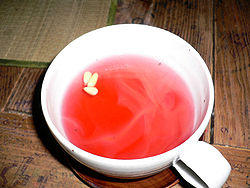
Omija hwachae
Encyclopedia

Schisandra chinensis
Schisandra chinensis is a deciduous woody vine native to forests of Northern China and the Russian Far East. It is hardy in USDA Zone 4. The plant likes some shade with moist, well-drained soil...
). It is usually served during the hot summer
Summer
Summer is the warmest of the four temperate seasons, between spring and autumn. At the summer solstice, the days are longest and the nights are shortest, with day-length decreasing as the season progresses after the solstice...
days as energy replenishment and for quenching thirst. Koreans made use of the herbs as remedy ingredients as well as traditional drinks. The plants, especially the fruits, have bright red
Red
Red is any of a number of similar colors evoked by light consisting predominantly of the longest wavelengths of light discernible by the human eye, in the wavelength range of roughly 630–740 nm. Longer wavelengths than this are called infrared , and cannot be seen by the naked eye...
colors, sticky, and also various tastes including sweet, sour, bitter and spicy resulted from its malic acid
Malic acid
Malic acid is an organic compound with the formula HO2CCH2CHOHCO2H. It is a dicarboxylic acid which is made by all living organisms, contributes to the pleasantly sour taste of fruits, and is used as a food additive. Malic acid has two stereoisomeric forms , though only the L-isomer exists...
and tartaric acid
Tartaric acid
Tartaric acid is a white crystalline diprotic organic acid. It occurs naturally in many plants, particularly grapes, bananas, and tamarinds; is commonly combined with baking soda to function as a leavening agent in recipes, and is one of the main acids found in wine. It is added to other foods to...
. To make omija hwachae, the fruits are dried and soaked in the water and then sieved. The sieved water then is added with sugar or honey. The punch is garnished with azalea petals if served during the spring; and if served with yellow rose petals, during summer.

